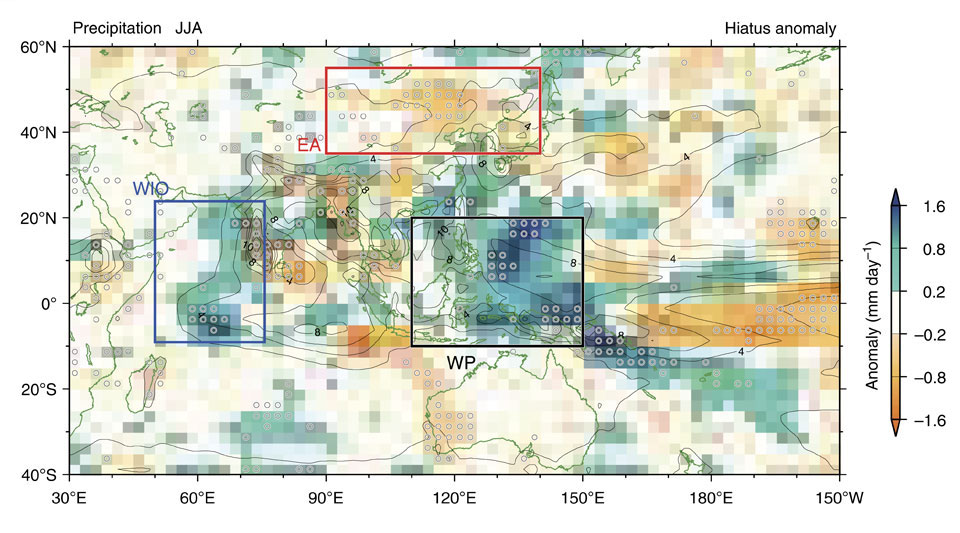Research Abstract
近年の太平洋の冷却化とインド洋の昇温がアジアモンスーンへ与える複合影響
Combined effects of recent Pacific cooling and Indian Ocean warming on the Asian monsoon
2015年11月13日 Nature Communications 6 : 8854 doi: 10.1038/ncomms9854

近年の研究によると、熱帯太平洋における過去15年間にわたる冷却化の傾向は、同期間の地球全体の気温上昇の停滞を引き起こした要因の一つであるとされる。停滞期間において、熱帯太平洋はラニーニャに似た冷却の分布を示すのに対して、インド洋における海面水温(SST)は上昇し続けていた。このSSTの分布は、ラニーニャに起因したインド洋の年々変動のスケールで生じる海盆規模の低い水温とは異なる。本論文では数値モデルの実験に基づき、停滞期間のSSTの分布は、アジアモンスーン域における降水偏差の地域性説明すると共に、水蒸気の変化に関係する熱力学的効果は副次的であることを示す。とくに、インド洋-太平洋におけるSSTの偏差は、熱帯西太平洋における対流活動を活発化させ、大気の遠隔影響(テレコネクション)を通して、東アジアの降水活動を抑制している。総じて熱帯太平洋のSSTの効果は、インド洋のSSTの効果と反対の関係にあり、前者は後者を上回っている。
Hiroaki Ueda, Youichi Kamae, Masamitsu Hayasaki, Akio Kitoh, Shigeru Watanabe, Yurisa Miki & Atsuki Kumai
Corresponding Author
Recent research indicates that the cooling trend in the tropical Pacific Ocean over the past 15 years underlies the contemporaneous hiatus in global mean temperature increase. During the hiatus, the tropical Pacific Ocean displays a La Niña-like cooling pattern while sea surface temperature (SST) in the Indian Ocean has continued to increase. This SST pattern differs from the well-known La Niña-induced basin-wide cooling across the Indian Ocean on the interannual timescale. Here, based on model experiments, we show that the SST pattern during the hiatus explains pronounced regional anomalies of rainfall in the Asian monsoon region and thermodynamic effects due to specific humidity change are secondary. Specifically, Indo-Pacific SST anomalies cause convection to intensify over the tropical western Pacific, which in turn suppresses rainfall in mid-latitude East Asia through atmospheric teleconnection. Overall, the tropical Pacific SST effect opposes and is greater than the Indian Ocean SST effect.

